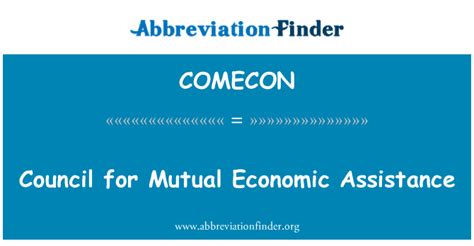Council For Mutual Economic Assistance

The Council for Mutual Economic Assistance, commonly referred to as COMECON, was a regional economic organization established in 1949 by the Soviet Union and its Eastern European socialist allies. The primary goal of COMECON was to promote economic cooperation and integration among its member states, which included the Soviet Union, Poland, Czechoslovakia, Hungary, Romania, Bulgaria, and East Germany. The organization aimed to coordinate the economic plans and activities of its member countries, facilitate the exchange of goods and services, and provide a framework for mutual assistance and cooperation in the areas of trade, industry, and technology.
COMECON was formed in response to the Marshall Plan, a U.S.-led initiative to rebuild Western Europe after World War II. The Soviet Union, which had suffered significant losses during the war, felt that the Marshall Plan was an attempt to undermine its influence in Eastern Europe and create a Western-oriented economic bloc. By establishing COMECON, the Soviet Union sought to create a rival economic organization that would promote socialist economic cooperation and integration, while also reducing the dependence of its Eastern European allies on Western trade and investment.
Key Points
- COMECON was established in 1949 to promote economic cooperation and integration among its member states
- The organization aimed to coordinate economic plans, facilitate trade, and provide mutual assistance in areas such as industry and technology
- COMECON was formed in response to the Marshall Plan, which the Soviet Union saw as a threat to its influence in Eastern Europe
- The organization played a significant role in promoting socialist economic cooperation and integration, but its effectiveness was limited by the lack of economic reform and the dominance of the Soviet Union
- COMECON was dissolved in 1991, following the collapse of communism in Eastern Europe and the Soviet Union
Structure and Activities of COMECON

COMECON was headquartered in Moscow and had a complex organizational structure, which included a council, an executive committee, and a secretariat. The council, which was the highest decision-making body, was composed of representatives from each member state and met annually to discuss and approve economic plans and policies. The executive committee, which was responsible for implementing the decisions of the council, was composed of representatives from each member state and met regularly to coordinate economic activities and resolve disputes.
COMECON had a number of specialized agencies and commissions, which were responsible for promoting cooperation in areas such as trade, industry, transportation, and science and technology. The organization also had a number of joint enterprises and projects, which were designed to promote economic integration and cooperation among its member states. For example, COMECON established a number of joint industrial projects, such as the Soviet-Polish-Czechoslovakian joint venture to produce trucks, and the Soviet-Hungarian joint venture to produce agricultural machinery.
Economic Cooperation and Integration
COMECON played a significant role in promoting economic cooperation and integration among its member states. The organization facilitated the exchange of goods and services, provided technical assistance and training, and coordinated economic plans and policies. COMECON also established a number of joint enterprises and projects, which helped to promote economic integration and cooperation among its member states. For example, the organization established a joint energy system, which allowed member states to share energy resources and reduce their dependence on Western energy supplies.
However, COMECON's effectiveness was limited by the lack of economic reform and the dominance of the Soviet Union. The organization's decision-making process was often slow and cumbersome, and the Soviet Union's dominance over the organization limited the ability of other member states to pursue their own economic interests. Additionally, the lack of economic reform in many member states limited the potential for economic cooperation and integration, and the organization's focus on heavy industry and centralized planning limited its ability to promote economic growth and development.
| Country | Year of Joining | Key Economic Indicators (1980) |
|---|---|---|
| Soviet Union | 1949 | GDP: $1.5 trillion, Industrial Production: 25% of world total |
| Poland | 1949 | GDP: $45 billion, Industrial Production: 2% of world total |
| Czechoslovakia | 1949 | GDP: $35 billion, Industrial Production: 1.5% of world total |
| Hungary | 1949 | GDP: $20 billion, Industrial Production: 1% of world total |
| Romania | 1949 | GDP: $25 billion, Industrial Production: 1.2% of world total |
| Bulgaria | 1949 | GDP: $15 billion, Industrial Production: 0.8% of world total |
| East Germany | 1950 | GDP: $30 billion, Industrial Production: 1.5% of world total |

Dissolution of COMECON

COMECON was dissolved in 1991, following the collapse of communism in Eastern Europe and the Soviet Union. The organization’s dissolution was a result of a number of factors, including the lack of economic reform, the dominance of the Soviet Union, and the collapse of communism in Eastern Europe. The dissolution of COMECON marked the end of a era of socialist economic cooperation and integration, and paved the way for the establishment of new economic organizations and initiatives in the region.
The dissolution of COMECON also had significant implications for the economies of its member states. Many of these countries faced significant challenges in transitioning to market-based economies, including high inflation, unemployment, and poverty. However, the dissolution of COMECON also created new opportunities for economic cooperation and integration, including the establishment of the Visegrad Group, which brought together the Czech Republic, Hungary, Poland, and Slovakia to promote economic cooperation and integration.
What was the primary goal of COMECON?
+The primary goal of COMECON was to promote economic cooperation and integration among its member states, which included the Soviet Union, Poland, Czechoslovakia, Hungary, Romania, Bulgaria, and East Germany.
How did COMECON facilitate economic cooperation and integration among its member states?
+COMECON facilitated economic cooperation and integration among its member states by coordinating economic plans and policies, facilitating the exchange of goods and services, providing technical assistance and training, and establishing joint enterprises and projects.
What were the limitations of COMECON's effectiveness?
+COMECON's effectiveness was limited by the lack of economic reform and the dominance of the Soviet Union. The organization's decision-making process was often slow and cumbersome, and the Soviet Union's dominance over the organization limited the ability of other member states to pursue their own economic interests.
In conclusion, COMECON played a significant role in promoting economic cooperation and integration among its member states, but its effectiveness was limited by the lack of economic reform and the dominance of the Soviet Union. The organization’s dissolution in 1991 marked the end of a era of socialist economic cooperation and integration, and paved the way for the establishment of new economic organizations and initiatives in the region. As the region continues to evolve and integrate into the global economy, it is essential to understand the history and legacy of COMECON, and to learn from its successes and failures.